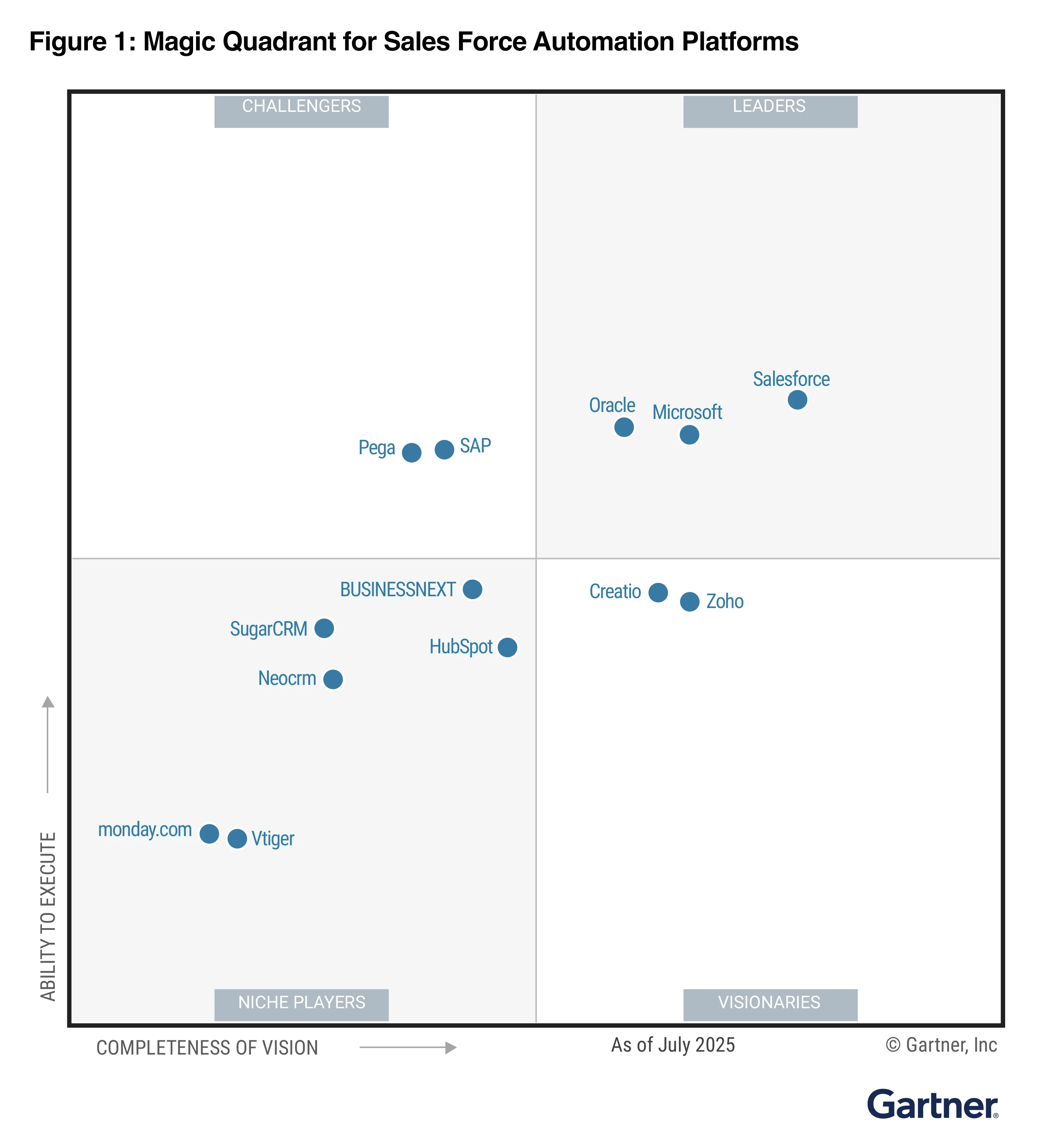
Selecting the right CRM platform has never been more complex. The market has evolved from simple customer databases into intelligent ecosystems connecting sales, marketing, and service with AI at the centre. For decision-makers, the question isn’t whether to upgrade — it’s which platform offers the best mix of innovation, usability, and long-term strategy.
The latest Forrester Wave™: Customer Relationship Management Software, Q1 2025 and the Gartner Magic Quadrant™ for Sales Force Automation Platforms 2025 offer valuable clarity. Together, they reveal which vendors lead the field and how their strengths align with modern business priorities.
Understanding the evaluation frameworks
Both Forrester and Gartner assess CRM vendors, but through different lenses.
Forrester’s Wave evaluates CRM vendors across three pillars: current offering, strategy, and market presence. It categorises each vendor into Leaders, Strong Performers, or Contenders.
Gartner’s Magic Quadrant, meanwhile, focuses on the ability to execute and completeness of vision within sales-force automation (SFA) platforms.
Together, they give a comprehensive view of the CRM market — Forrester provides depth across CRM features, while Gartner highlights vendors’ operational excellence and scalability.
The leaders at a glance
According to Forrester Q1 2025, the Leaders quadrant features Salesforce, Microsoft, Oracle, and Pegasystems, all recognised for their strong product capabilities and forward-looking strategies.
The following CRM system ranking from Forrester’s Q1 2025 report highlights the top-ranked CRM software vendors driving innovation and customer engagement across industries.
These results reinforce a trend: vendors that blend mature CRM features with embedded AI and strong ecosystems are setting the pace for the industry. Microsoft Dynamics 365: A dual-recognised leader
Microsoft stands out as a Leader in both Forrester’s and Gartner’s 2025 reports, showcasing a balance between product strength and visionary strategy.
Why Microsoft excels
-
AI and automation: Dynamics 365 Sales integrates generative and autonomous AI to streamline workflows and guide sellers with contextual insights. This marks the shift toward agentic sales, where AI agents automate research, qualification, and follow-up tasks.
-
Ecosystem integration: Tight connections across Microsoft 365, Teams, and Power Platform ensure fluid collaboration and shared customer data.
-
Proven client impact: Ricoh Japan’s deployment of Dynamics 365 Sales improved forecasting and enhanced efficiency through the use of embedded AI and Microsoft Copilot.
Key Forrester scores for Microsoft
| Criterion |
Score (out of 5) |
| Contact and account management |
5.0 |
| Lead and sales execution |
5.0 |
| AI (predictive, generative, agentic) |
5.0 |
| Vision and roadmap |
5.0 |
These high marks reflect Microsoft’s commitment to unifying CRM, analytics, and AI into one intelligent business platform.
For a deeper dive into how Microsoft Copilot and Dynamics 365 reshape CRM and sales automation, see ARP Ideas’ expert article on integrating Copilot into enterprise workflows.
Detailed Forrester evaluation breakdown
This section presents the full scoring details from The Forrester Wave™: Customer Relationship Management Software, Q1 2025, comparing all major vendors.
How to interpret the table
-
Scores range from 1 to 5, with 5 representing superior performance.
-
The left column lists evaluation criteria across the current offering and strategy.
-
Vendors are scored in parallel, showing comparative strengths in key areas like AI capabilities, process management, and partner ecosystem.
This table demonstrates why Salesforce and Microsoft lead the field. Salesforce tops the chart with a combined score of 4.04, while Microsoft scores 3.68 overall, boosted by perfect marks in AI and usability. Oracle and Pegasystems follow closely, showing competitive advantage in automation and security.
Microsoft Named a Leader in Gartner’s 2025 Magic Quadrant for Sales Force Automation Platforms
Gartner’s 2025 Magic Quadrant for Sales Force Automation Platforms recognises Microsoft as a Leader: its fifteenth consecutive year in the Leaders quadrant. In Microsoft’s summary, the company credits Dynamics 365 Sales’ embedded AI and “agentic” capabilities with Copilot, along with deep integration across the Microsoft Cloud (including Teams and Power Platform), for streamlining seller workflows from lead research and qualification to forecasting. The 2025 Magic Quadrant was published on July 21, 2025, underscoring Microsoft’s sustained leadership in enterprise SFA.
Other leading vendors and their distinct strengths
Salesforce
-
Highest overall score in Forrester’s ranking (4.04).
-
Rated 5/5 for lead management, sales execution, AI trust and security, and global deployment.
-
Dominates in the partner ecosystem and extensibility through its AppExchange.
Oracle
Pegasystems
-
Excels in process management and case handling, with consistent 5/5 ratings in automation-focused categories.
-
Favoured by organisations requiring deep workflow customisation.
Emerging challengers
Creatio and HubSpot demonstrate impressive flexibility and usability for smaller or rapidly scaling businesses, although they fall behind the leaders in enterprise-scale capabilities.
What defines CRM success in 2025
The reports make one thing clear: CRM success now depends on intelligence, usability, and alignment with business goals.
Key success drivers include:
-
AI-first architecture – predictive and generative AI embedded natively into workflows.
-
Cross-system integration – connection between CRM, ERP, marketing, and service tools.
-
Data security and trust – transparent AI use and strong compliance frameworks.
-
Adoption and user enablement – Forrester highlights adoption as a 13% weighted factor in CRM success.
Organisations should benchmark their priorities against these criteria to narrow their shortlist effectively.
Comparative overview
| Vendor |
Forrester 2025 Rating |
Gartner 2025 Rating (summary) |
Distinct Advantage |
| Salesforce |
Leader – comprehensive end-to-end CRM ecosystem; excels in lead management, AI trust, and partner network. |
Leader – strong execution and broad ecosystem for large enterprises |
Deep CRM ecosystem with strong partner extensions |
| Microsoft |
Leader – balanced offering and strategy; unified data, AI, and usability with Copilot integration |
Leader – 15th consecutive year; recognised for embedded AI, “agentic” Copilot, and Microsoft Cloud integration |
Unified data and AI-driven productivity across the Microsoft Cloud |
| Oracle |
Strong Performer – data management and AI governance; tight ERP integration |
Visionary / Strong Performer – advanced analytics and ERP synergy |
End-to-end ERP + CRM analytics strength |
| Pegasystems |
Strong Performer – automation and case management excellence |
Challenger – specialises in process automation and workflow customisation |
Deep process automation and case handling |
| Creatio |
Contender – strong low-code platform and adaptability |
Niche Player – appealing for mid-market flexibility |
Low-code CRM for fast scaling businesses |
| HubSpot |
Contender – simplicity and usability for SMBs |
Niche Player – user-friendly sales and marketing automation for small teams |
Ease of use and rapid adoption for SMBs |
Benefits and limitations of top-tier CRMs
Benefits
-
AI-driven workflows improve seller productivity and forecast accuracy.
-
Unified data enhances customer visibility and collaboration.
-
Automation reduces operational cost and human error.
Limitations
-
Complex adoption cycles in enterprise environments.
-
High licensing costs for top vendors.
-
Risk of over-customisation leading to slower innovation cycles.
Understanding CRM Costs in 2025
When evaluating your next CRM platform, understanding the cost structures of CRMs is essential. Modern CRM software costs vary widely depending on deployment model, licensing, and included features. Cloud-based systems, such as Microsoft Dynamics 365 and Salesforce, typically follow a subscription-based model, with pricing tiers based on user roles, modules, and storage requirements. On-premises CRM solutions, while offering greater control, often involve higher upfront investment and maintenance costs.
The cost of CRM should therefore be viewed not only in terms of licences, but also through the lens of long-term value — including automation efficiency, integration potential, and user adoption. Organisations that align their CRM investment with strategic goals often see the highest returns in customer engagement and operational agility.
Key takeaways
-
Salesforce and Microsoft continue to lead the CRM market, with the most balanced combination of features and innovation.
-
AI and automation define the next wave of CRM value.
-
Integration and ecosystem strength are now as critical as feature breadth.
-
Oracle and Pegasystems remain top choices for organisations focused on process automation and data depth.
-
Every CRM project should start with strategy alignment and readiness assessment.
FAQ
What’s the main difference between Forrester and Gartner evaluations?
Forrester analyses broader CRM functionality, while Gartner focuses on sales-force automation performance and execution capability.
Does a Leader position guarantee suitability?
Not necessarily. It indicates strong performance across most criteria, but success depends on internal adoption, scalability needs, and budget.
How much does AI matter in CRM selection?
AI is now central. Gartner predicts 15% of daily sales decisions will be made autonomously by AI agents by 2028, up from 0% in 2024.
Where can I read the full reports?
Forrester’s report is available here, and Microsoft’s summary of Gartner’s Magic Quadrant 2025 can be found here.
Conclusion
If you’re considering your next CRM move, now is the time to assess your current setup, define your objectives, and map them against what the market’s top platforms can deliver.
Ready to explore what Dynamics 365 could mean for your organisation?
Contact ARP Ideas for a tailored consultation on CRM strategy, platform evaluation, and digital transformation planning.
CEO and Co-Owner of ARP Ideas
A visionary leader and technology enthusiast. He inspires organisations to embrace digital transformation by harnessing the power of modern technologies. With deep expertise in Microsoft solutions and a future-focused mindset, he helps businesses turn bold ideas into real-world impact.





